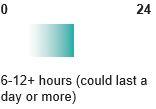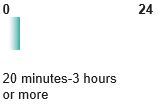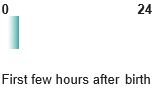| Stage | Length *The bars below represent a 24-hour labour |
Contractions | Dilation | Emotions | Tips |
|---|---|---|---|---|---|
1st StageEarly Labour |

|

|
0-4 cm |

Excited, anxious |
Stay at home, rest, take a short walk, or do light activities. |
1st StageActive Labour |

|

|

4-8 cm |

More serious, focused |
Use different positions, breathing exercises, and relaxation techniques. |
1st StageTransition |

|

|

8-10 cm |

Frustrated, dependent |
You may feel nauseous or shaky. Support people need to provide focus. |
2nd StagePushing & Birth |

|

|

10 cm |

Relieved, energized |
Use different positions to push. Support people can provide encouragement. |
3rd & 4th StagePlacenta, Recovery, & Breast- feeding |

|
|
The cervix closes in the days after birth. |

Happy, bonding |
Hold your baby skin to skin for at least an hour right after birth. |
1. When to go to hospital
It’s likely that you won’t need to go to the hospital until your contractions are 5 minutes apart, last 1 minute each, and continue in this pattern for 1 hour. Use 511 as a general guide—always follow your healthcare provider’s instructions.
2. How do you know you are in labour
- Tighten portions of the uterus
- Don’t usually cause back pressure
- Ease up over time
- Have no regular pattern
- May stop when you change your activity by resting, walking, or taking a warm bath
- Do not cause the cervix to change
- Eventually tighten the entire uterus
- Usually cause pressure on the lower back and/or lower belly
- Last longer over time
- Become stronger over time
- Grow closer together
- Do not stop when you change your activity, and walking may make them stronger
- Cause the cervix to thin and open
© 2017 InJoy Productions, Inc. All rights reserved.